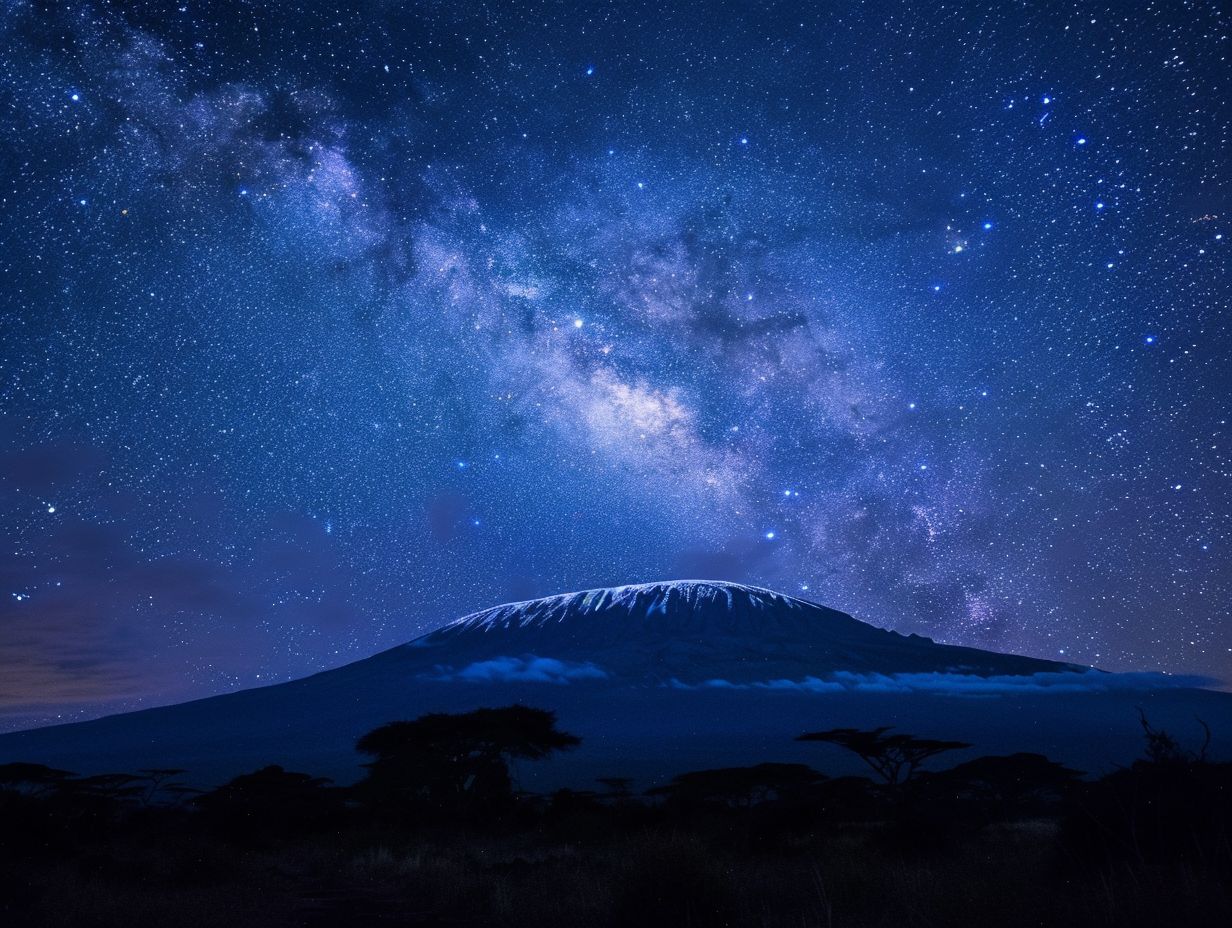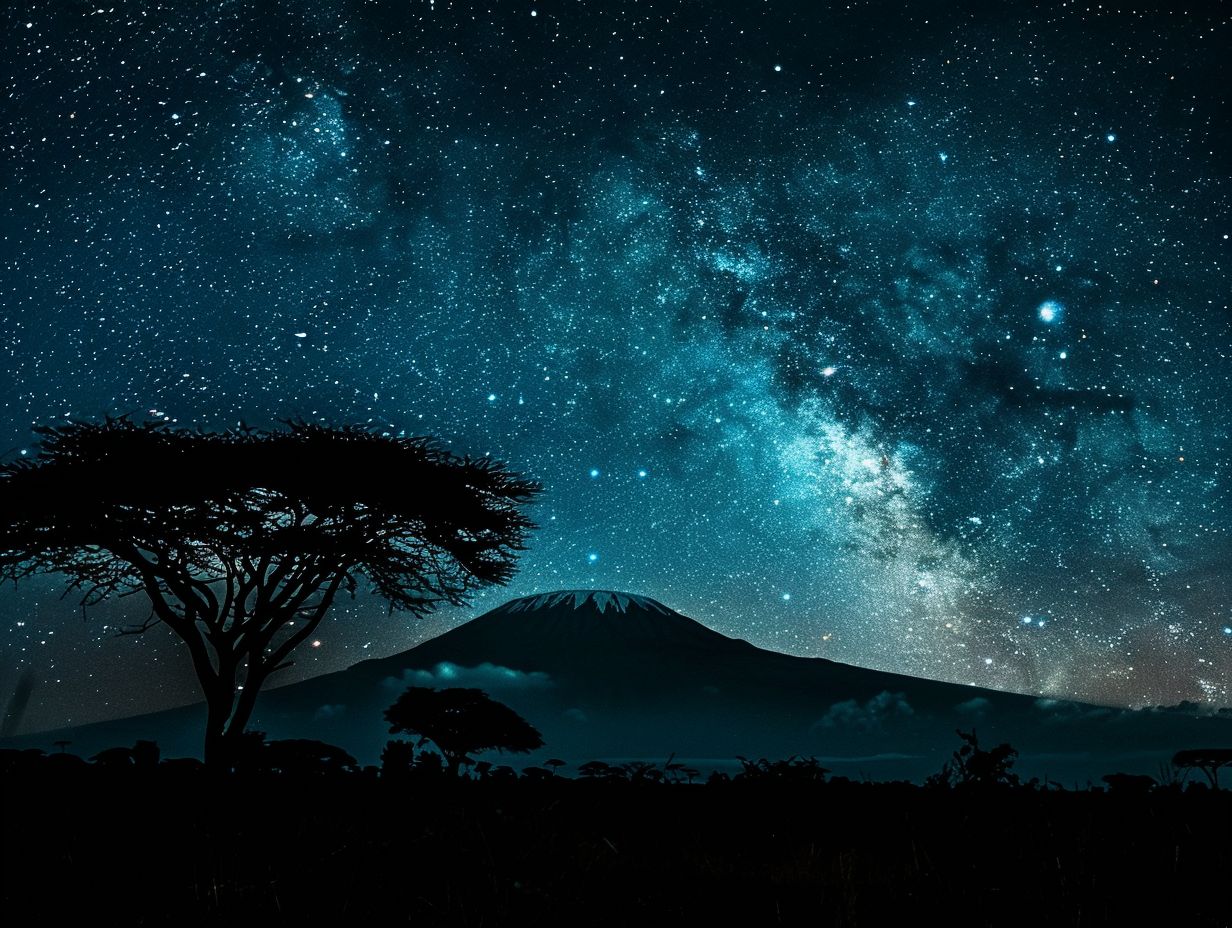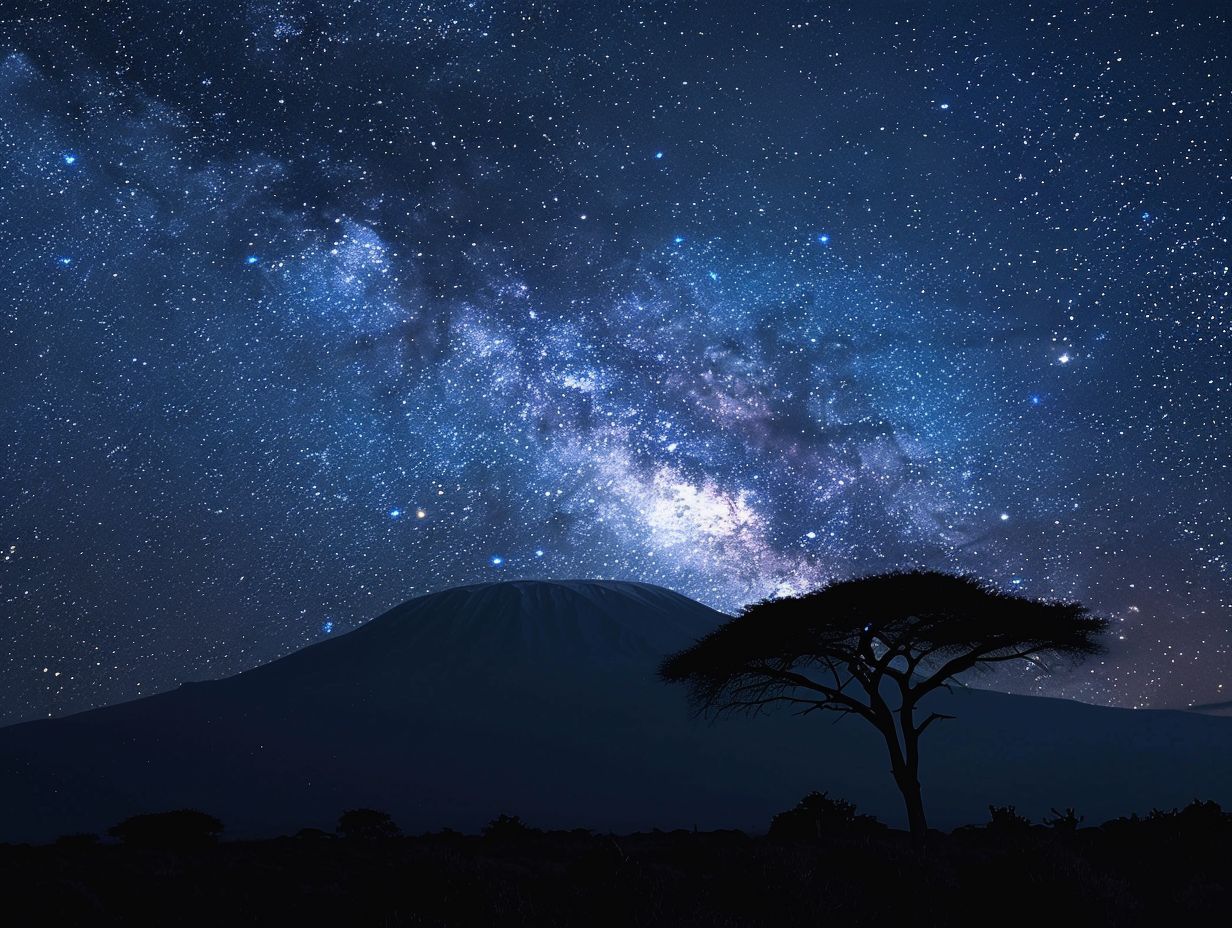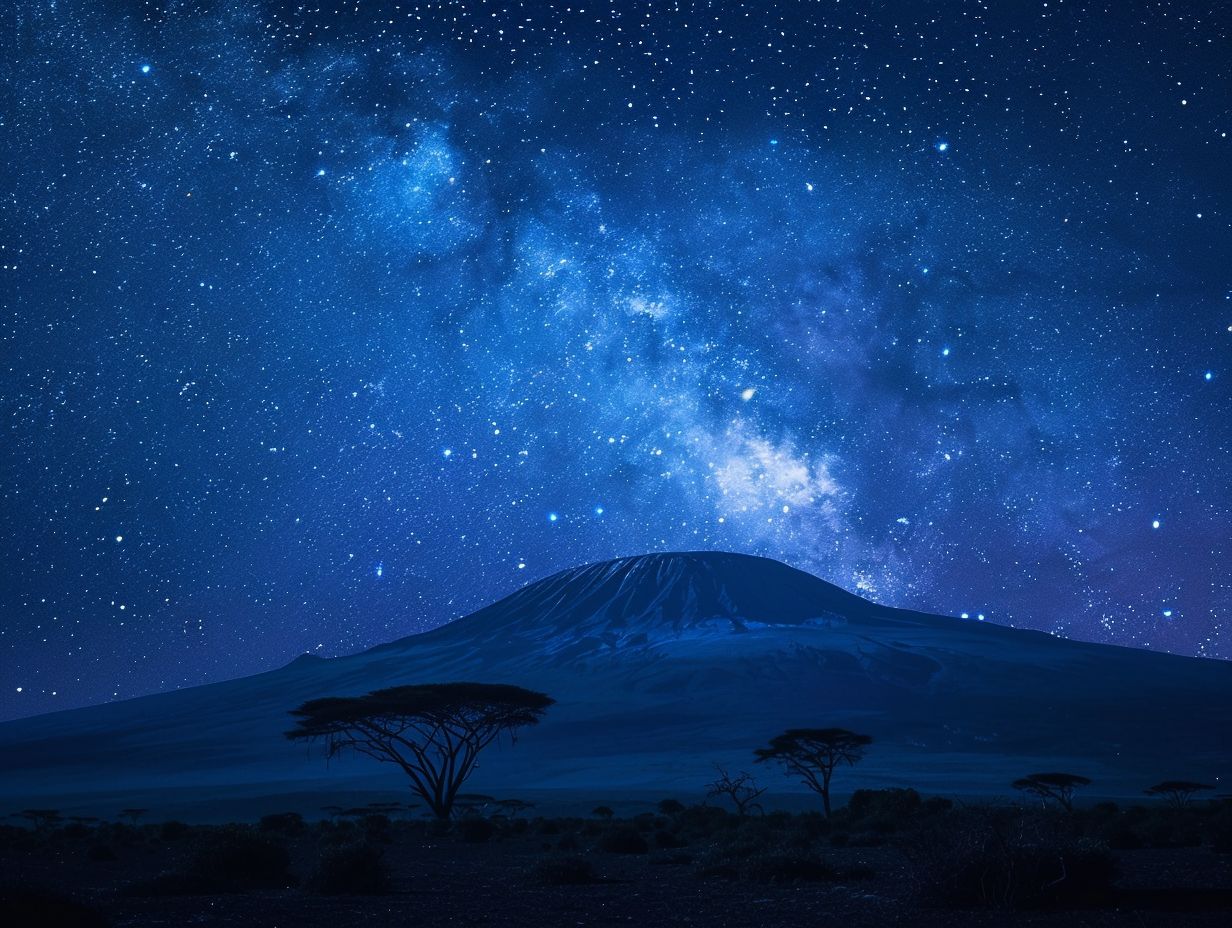
Kilimanjaro Summit Night
Embarking on the iconic Kilimanjaro Summit Night is a thrilling and challenging experience that tests both physical and mental endurance.
In this article, we will explore the importance of reaching the summit, the challenges faced during the ascent, and how to adequately prepare for the journey.
From dealing with altitude sickness to extreme cold weather, we will discuss the obstacles that climbers may encounter. We will delve into the best time to attempt the climb and the various routes available for this epic adventure.
Key Takeaways:

- Reaching the summit of Kilimanjaro is a significant achievement both physically and mentally.
- Proper training and gear preparation are essential for a successful summit night.
- The best time to attempt Kilimanjaro summit night is during the dry season (June-October).
What Is the Importance of Kilimanjaro Summit Night?
Kilimanjaro Summit Night holds immense importance as it marks the pinnacle of the climb, providing unparalleled views from the highest point in Africa.
Ascending Kilimanjaro at night adds an extra layer of challenge to an already demanding endeavor.
Navigating the rugged terrain, guided only by the shimmering glow of stars above and the flickering beams of headlamps, creates an otherworldly experience.
The dark silhouette of the mountain against the night sky, gradually illuminated by the rising sun, is a moment etched in the memory forever.
The achievement of reaching the summit under these conditions amplifies the sense of accomplishment and victory.
What Is the Significance of Reaching the Summit?
Reaching the summit of Kilimanjaro, such as Uhuru Peak, stands as a monumental achievement that showcases the resilience and determination of climbers.
Summiting Kilimanjaro not only tests the physical limits of climbers but also challenges their mental stamina, requiring unwavering focus and perseverance throughout the trek.
The sense of accomplishment that washes over a climber as they stand atop the highest peak in Africa is unparalleled, instilling a profound sense of pride and triumph.
The panoramic view of the vast African plains illuminated by the gentle hues of the rising sun paints a picture of sheer magnificence, etching memories that linger as an everlasting reminder.
What Are the Challenges of Kilimanjaro Summit Night?
The challenges of Kilimanjaro Summit Night are multifaceted, ranging from altitude sickness due to the extreme elevation gain, bone-chilling cold weather, to physical exhaustion.
1. Altitude Sickness
Altitude sickness, a common challenge during Kilimanjaro Summit Night, is caused by the decreased oxygen levels at higher altitudes, leading to symptoms like headaches, nausea, and dizziness.
When climbers ascend rapidly, their bodies don’t have adequate time to acclimatize to the diminishing oxygen levels, which triggers altitude sickness.
Some severe cases can even lead to fluid accumulation in the lungs or brain, requiring immediate descent to lower altitudes for treatment.
To combat this, climbers are advised to maintain a slow and gradual ascent, stay well-hydrated, and consume high-carbohydrate meals.
Preventive medications like acetazolamide can assist in alleviating symptoms by stimulating faster acclimatization.
Recognizing the early signs of altitude sickness and promptly addressing them can significantly enhance climbers’ safety and chances of summit success.”
2. Extreme Cold Weather
The extreme cold weather conditions encountered during Kilimanjaro Summit Night can pose significant challenges as temperatures plummet, requiring climbers to bundle up in layers.
In such harsh environments, the frigid temperatures not only test a climber’s physical endurance but also impact their gear and clothing.
Equipment like ropes, harnesses, and carabiners can become stiff and brittle, making them challenging to maneuver. Even clothing choices play a crucial role.
The biting cold can hinder dexterity, making simple tasks like adjusting gear or zippers a cumbersome ordeal.
3. Physical Exhaustion

Climbers often face physical exhaustion during Kilimanjaro Summit Night due to the demanding trek, high altitude, and prolonged effort, necessitating mental resilience to push through.
When ascending Kilimanjaro, the rigorous journey to Uhuru Peak demands not only physical strength but also mental endurance.
The extreme conditions and thinning air at higher altitudes intensify the exertion on the body, making each step a formidable task.
Climbers must maintain a steady pace, knowing when to take rest stops to prevent overexertion and acclimatize.
These breaks not only allow the body to recover but also provide moments of respite for the mind, allowing climbers to regroup and gather their resolve for the next leg of the climb.
How to Prepare for Kilimanjaro Summit Night?
Proper preparation is key to conquering Kilimanjaro Summit Night, involving physical training to build endurance, acclimatization to adjust to high altitudes, and packing appropriate gear to withstand the challenging conditions of the ascent.
1. Train for Physical Fitness
Training for physical fitness before attempting Kilimanjaro Summit Night is crucial, as it helps build the strength and endurance needed to tackle the challenging terrain.
The physical demands of Kilimanjaro Summit Night necessitate a well-rounded fitness regime that includes cardiovascular exercises like running, cycling, and stair climbing to improve endurance.
Strength training focusing on the legs, core, and upper body is vital for navigating the steep slopes and carrying gear.
Along with gym workouts, simulating hiking conditions by including long uphill walks, hill repeats, and stair climbs in training sessions can better prepare climbers for the diverse terrain of the mountain.
2. Acclimatize Properly
Proper acclimatization is essential for Kilimanjaro Summit Night, as it allows the body to adjust to higher altitudes, increase oxygen intake, and recover effectively.
Acclimatization techniques include gradual altitude gain, hydration, slow hiking pace, and sufficient rest to help the body adjust to the reduced oxygen levels at higher altitudes.
Recovery practices such as adequate sleep, nutrition, and avoiding alcohol aid in restoring energy levels and muscle function after strenuous climbs.
Maintaining proper oxygen intake through deep breathing exercises and using supplemental oxygen if needed can significantly enhance endurance and combat symptoms of altitude sickness.
3. Pack Appropriate Gear
Packing appropriate gear for Kilimanjaro Summit Night is crucial, including warm clothing, insulated layers, energy-boosting snacks, and hydration supplies to combat the cold.
For Kilimanjaro Summit Night, essentials include moisture-wicking base layers , a down jacket for insulation, waterproof/windproof outer layers, and sturdy boots with traction.
Don’t forget to pack high-energy snacks like nuts, dried fruits, granola bars, and chocolate for quick bursts of energy, as well as electrolyte tablets or powders to replenish essential minerals lost through sweat.
Carrying a hydration reservoir or insulated water bottle is essential to ensure constant access to fluids, while energy gels or chews can provide a quick energy boost during strenuous sections of the climb.
What Is the Best Time to Attempt Kilimanjaro Summit Night?
The dry season (June-October) offers favorable weather conditions and clear skies, while the wet season (November-May) presents challenges like rain and slippery trails.
1. Dry Season (June-October)
The dry season from June to October is ideal for Kilimanjaro Summit Night, offering stable weather with clear skies and reduced precipitation.
During this period, climbers experience crisp air and cooler temperatures, which are more conducive to strenuous physical activity.
The well-defined trails, free from mud and slippery conditions, make navigating the mountain much easier and safer.
The clarity of the skies at night enhances visibility, allowing climbers to marvel at the breathtaking starlit sky as they make their way to the summit.
Decreased cloud cover means that sunrise views from the Uhuru Peak, the highest point on Kilimanjaro, are often unobstructed and absolutely spectacular.
2. Wet Season (November-May)

The wet season, from November to May, presents challenges due to increased rainfall, muddy trails, and higher humidity, making the climb more demanding.
The rain during the wet season not only creates slippery conditions but also affects visibility, adding to the difficulty of navigating through the trail.
Trekkers need to be extra cautious of their footing to avoid accidents or injuries exacerbated by the wet and muddy terrain.
Safety measures such as using trekking poles, wearing proper waterproof gear, and staying alert for potential hazards become crucial during such climbs.
Overcoming the weather-related challenges involves mental resilience, physical endurance, and the ability to adapt quickly to changing conditions.
What Is the Route for Kilimanjaro Summit Night?
Selecting the right route for Kilimanjaro Summit Night is crucial, with options like the Marangu, Machame, Lemosho, Rongai, and Umbwe routes offering varying terrains, challenges, and scenic views on the journey to the iconic Uhuru Peak.
Each of these routes has its own unique characteristics. For example, the Marangu route, often called the ‘Coca-Cola route’ due to its popularity, is known for its gradual ascent and hut accommodations.
1. Marangu Route
The Marangu Route, also known as the ‘Coca-Cola’ route, is one of the most popular paths, featuring comfortable hut accommodations and gradual ascent.
One of the distinguishing features of the Marangu Route is its unique sleeping arrangements in huts along the trail.
These hut accommodations offer basic facilities, including bunk beds and communal dining areas, enhancing the comfort level during the trek.
While some trekkers appreciate the convenience of hut stays, others prefer the flexibility and connection with nature that camping provides.
The gradual ascents on the Marangu Route allow for better acclimatization to the increasing altitudes, reducing the risk of altitude sickness.
This slow and steady approach enhances safety and makes the trek more manageable for individuals who might struggle with rapid altitude changes.
Despite its advantages, the Marangu Route is not without its challenges.
The well-beaten path, often referred to as the ‘tourist route,’ can be crowded during peak seasons, diminishing the sense of isolation and wilderness.
The continuous ascent and descent on the same path may lead to monotony for those looking for a more varied experience.
2. Machame Route
The Machame Route, known for its scenic beauty and diverse terrain, with steep ascents, varied landscapes, and stunning views along the way.
One of the highlights of the Machame Route is its unique vegetation zones, provide trekkers with a truly immersive experience.
The route also allows for proper altitude acclimatization thanks to its gradual ascent profile, reducing the risk of altitude sickness.
Trekking through the Barranco Wall, a thrilling scramble section, adds an exciting element to the journey.
The Machame Route is popular for its amazing sunrises over Mawenzi peak, creating unforgettable moments for climbers.
3. Lemosho Route

The Lemosho Route, known for its scenic variety and high success rates, allows for better acclimatization and breathtaking views.
One of the standout features of the Lemosho Route is the diversity in landscapes that trekkers encounter along the way.
From lush rainforests at the lower elevations to alpine meadows as you ascend higher, each day brings a new visual feast for the eyes.
The route offers several camping options at different elevations, allowing hikers to adjust to the altitude more effectively.
These campsites are strategically placed to optimize acclimatization and reduce the risk of altitude sickness.
With its gradual climb and longer duration, the Lemosho Route is ideal for those seeking a more relaxed and scenic journey.
4. Rongai Route
The Rongai Route, starting from the northern side of Kilimanjaro, offers a less traveled path, showcasing the mountain’s quieter landscapes.
One of the features that distinguish the Rongai Route from other trails is its tranquil ambiance, with fewer climbers and a sense of solitude.
This allows trekkers to immerse themselves fully in the serenity of Kilimanjaro’s northern slopes, away from the crowds often found on the more popular routes.
Adding to its allure is the stunning scenery that unfolds along the way.
The route unveils breathtaking panoramas of both the northern circuit and the Kenyan plains, offering a different perspective of the mountain’s grandeur.
The Rongai Route facilitates a more gradual ascent compared to some of the steeper paths, allowing climbers to adjust to the altitude in a gentler manner.
This approach contributes significantly to a higher success rate in reaching the summit as it aids in minimizing the risk of altitude sickness and exhaustion.
5. Umbwe Route
The Umbwe Route, offers a challenging and less frequented trail that appeals to experienced climbers seeking a rugged and adventurous ascent experience.
The unique characteristics of the Umbwe Route make it stand out among the various options for ascending Kilimanjaro.
Its steep terrain and direct ascent present a thrilling challenge for those looking to test their skills and endurance.
The trail conditions on the Umbwe Route can be rugged, with rocky sections and uneven paths adding to the difficulty.
The lack of crowds on this route provides a more solitary experience, allowing climbers to immerse themselves fully in the natural beauty.
Despite its challenges, the Umbwe Route rewards adventurers with breathtaking views of the Kilimanjaro landscape and a sense of accomplishment like no other.
For those seeking a truly memorable and demanding climb, this route offers the perfect combination of adventure and unparalleled natural beauty.
Frequently Asked Questions
1. What is Kilimanjaro Summit Night?
A: Kilimanjaro Summit Night refers to the final night of the trek to the summit of Mount Kilimanjaro. It is typically the most challenging and longest night of the climb as it involves reaching the Uhuru Peak, the highest point of the mountain.
2. What time does Kilimanjaro Summit Night usually start?
A: The summit night on Kilimanjaro usually begins around midnight or early morning, depending on the route and pace of the trek. This is to ensure that climbers reach the peak at sunrise, which offers the best views and weather conditions.
3. How long does it take to reach the top on Kilimanjaro Summit Night?
A: The duration of the summit night climb can vary depending on the route and individual pace, but it typically takes 6-8 hours to reach the Uhuru Peak. The descent can take an additional 4-6 hours, making it a total of 10-14 hours for the entire night.
4. What should I expect during Kilimanjaro Summit Night?
A: Kilimanjaro Summit Night is a physically and mentally demanding climb. The terrain is steep and rocky, and the altitude can make breathing difficult. Climbers should also be prepared for extreme cold temperatures and possibly strong winds.
5. Do I need any special gear for Kilimanjaro Summit Night?
A: Yes, proper gear is essential for a safe and comfortable summit night on Kilimanjaro. This includes warm and waterproof clothing, sturdy hiking boots, headlamp, trekking poles, and a good sleeping bag. It is also recommended to have a portable oxygen supply in case of altitude sickness.
6. Is Kilimanjaro Summit Night safe?
A: While Kilimanjaro Summit Night can be physically and mentally challenging, it is relatively safe if proper precautions are taken. Climbers should be well-prepared, acclimatized, and listen to their guides’ instructions. In the unlikely event of an emergency, there are trained guides and rescue teams available on the mountain.